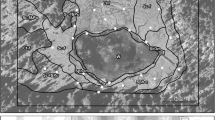Abstract
Peatlands have traditionally been exploited in forestry and agriculture over the boreal region, yet they also provide substantial source of fuel production. The large-scale exploitation of peatlands has raised a concern about the diversity of mire plant communities. We studied composition of mire plant communities along soil nutrient potential and water content gradients, to recognize the areas with the high plant diversity. Soil electrical conductivity (ECb) was measured to characterise soil nutrient regimes and soil dielectric permittivity (DP) the soil (volumetric) water regimes. A total of 115 mire sites were studied in the central boreal region of south-western Finnish Lapland. We found that Ward’s hierarchical cluster analysis produced eight stable ECb and DP clusters with discrete vegetation compositions. On the basis of a locally weighted regression analysis (Loess), Carex dioica L., Comarum palustre L., Equisetum fluviatile L., Menyanthes trifoliata L., and Scorpidium scorpioides (Hedw.) Limpr. were found as indicator species for nutrient-rich regimes as designated by high soil ECb. The soil ECb is a diagnostic measure of plant diversity as ECb > 7 mSm−1 resulted in a considerable increase in species richness. Our classification method, based on electrical measurements, provides a simple way to classify mires and focus detailed research to areas with potentially high conservation value.





Similar content being viewed by others
References
Aapala K (ed) (2001) Soidensuojeluverkon arviointi (Assessment of the network of protected mires in Finland). Suomen ympäristö 490. Finnish Environment Institute
Arkimaa H, Middleton M, Hyvönen E, Kuosmanen V, Laitinen J, Sutinen R (2005) Mire site type mapping of boreal peatlands with hyperspectral airborne HyMap in northern Finland. In: Zagajewski B, Sobczak M, Wrzesień M (eds) Proceedings of 4th EARSeL workshop on imaging spectroscopy, pp 355–362. EARSeL & Warsaw University
Bragazza L, Gerdol R (2002) Are nutrient availability and acidity-alkalinity gradients related in Sphagnum-dominated peatlands? J Veg Sci 13:473–482
Bray JR, Curtis JT (1957) An ordination of the upland forest communities of southern Wisconsin. Ecol Monogr 27:325–349
Bridgham SD, Pastor J, Janssens JA, Chapin C, Malterer TJ (1996) Multiple limiting gradients in peatlands: a call for a new paradigm. Wetlands 16:45–65
Davies CE, Moss D (1999) EUNIS habitat classification. European Topic Centre on Nature Conservation, European Environment Agency
R Development Core Team (2008) R. http://www.r-project.org
Dutilleul P (1993) Modifying the t test for assessing the correlation between two spatial processes. Biometrics 49:305–314
Eurola S, Hicks S, Kaakinen E (1984) Key to Finnish mire types. In: Moore, PD (ed) European mires, pp 11–118. Academic
Eurola S, Bendiksen K, Rönkä A (1992) Suokasviopas (Mire plant guide). Oulanka reports 11. Oulanka Biological Station, University of Oulu
Eurola S, Huttunen A, Kukko-oja K (1995) Suokasvillisuusopas (Mire type guide). Oulanka reports 14. Oulanka Biological Station, University of Oulu
Faith DP, Minchin PR, Belbin L (1987) Compositional dissimilarity as a robust measure of ecological distance. Vegetatio 69:57–68
Hämet-Ahti L, Suominen J, Ulvinen T, Uotila P (eds) (1998) Retkeilykasvio (Field flora of Finland). Botanical Museum, Finnish Museum of Natural History
Legendre P (2008) Modified t-test program. Université de Montréal, Département des sciences biologiques. http://www.bio.umontreal.ca/Casgrain/en/labo/mod_t_test.html
Levin SA (1992) The problem of pattern and scale in ecology. Ecology 73:1943–1967
Malmer N (1986) Vegetation gradients in relation to environmental conditions in northwestern European mires. Can J Bot 64:375–383
Nyyssönen A, Ahti A (eds) (1996) Proceedings of FAO expert consultation on global forest resources assessment 2000 in cooperation with ECE and UNEP with the support of the government of Finland. Metsäntutkimuslaitoksen tiedonantoja 620. Finnish Forest Research Institute
Økland RH, Økland T, Rydgren K (2001) A Scandinavian perspective on ecological gradients in north-west European mires: reply to Wheeler and Proctor. J Ecol 89:481–486
Oksanen J, Kindt R, Legendre P, O’Hara, Simpson GL, Solymos P, Stevens MHH, Wagner H (2008) Vegan. Community ecology package. http://cran.r-project.org/web/packages/vegan
Orlóci L (1967) An agglomerative method for classification of plant communities. J Ecol 55:193–206
Puranen R, Sulkanen K, Nissinen R, Simelius P (1999) Ominaisvastusluotaimet ja vastustalikot (Resistivity probes and forks). Unpublished report Q15/27.4/99/2.8. Geological Survey of Finland
Reinikainen A, Mäkipää R, Vanha-Majamaa I, Hotanen J-P (eds) (2001) Kasvit muuttuvassa metsäluonnossa (Changes in the frequency and abundance of forest and mire plants in Finland since 1950). Tammi
Rhoades JD, Oster JD (1986) Solute content. In: Klute A (ed) Methods of soil analysis. Part 1. Agronomy monograph 9, pp 985–1006. American Society of Agronomy
Shannon CE, Weaver W (1949) The mathematical theory of communication. The University of Illinois Press.
Sjörs H, Gunnarsson U (2002) Calcium and pH in north and central Swedish mire waters. J Ecol 90:650–657
Tahvanainen T, Sallantaus T, Heikkilä R, Tolonen K (2002) Spatial variation of mire surface water chemistry and vegetation in northeastern Finland. Ann Bot Fenn 39:235–251
Topp GC, Davis JL, Annan AP (1980) Electromagnetic determination of soil water content: measurements in coaxial transmission lines. Water Resour Res 16:574–582
Verhoeven JTA, Maltby E, Schmitz MB (1990) Nitrogen and phosphorus mineralization in fens and bogs. J Ecol 78:713–726
Waughman GJ (1980) Chemical aspects of the ecology of some south German peatlands. J Ecol 68:1025–1046
Wells ED (1996) Classification of peatland vegetation in Atlantic Canada. J Veg Sci 7:847–878
Wheeler RD, Proctor MCF (2000) Ecological gradients, subdivisions and terminology of north-west European mires. J Ecol 88:187–203
Whittaker RJ, Willis KJ, Field R (2001) Scale and species richness: towards a general, hierarchical theory of species diversity. J Biogeogr 28:453–470
Acknowledgements
This article was a part of the project “Forets soils and global change” at the Geological Survey of Finland focusing on soil electrical classification. The comments by two anonymous referees significantly improved the manuscript. Kent Middleton revised the English language.
Author information
Authors and Affiliations
Corresponding author
Additional information
Responsible Editor: Gerlinde De Deyn.
Rights and permissions
About this article
Cite this article
Närhi, P., Middleton, M., Hyvönen, E. et al. Central boreal mire plant communities along soil nutrient potential and water content gradients. Plant Soil 331, 257–264 (2010). https://doi.org/10.1007/s11104-009-0250-4
Received:
Accepted:
Published:
Issue Date:
DOI: https://doi.org/10.1007/s11104-009-0250-4



